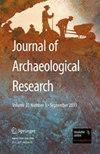可持续农业考古
IF 4.1
1区 历史学
Q1 ANTHROPOLOGY
引用次数: 36
摘要
考古学将如何促进农业的可持续性?为了解决这个问题,本文概述了考古学促进我们对可持续农业理解的多种互补方式。在这里,我通过联合国粮食及农业组织使用的可持续农业五项原则来评估最近的考古研究。这些原则——效率、保护、农村生计、复原力和治理——突出了农业可持续性的社会和环境层面。通过借鉴世界各地的案例研究,我展示了考古学是如何在很长一段时间内研究这些社会和环境维度的相互作用。考古学对可持续农业的最大概念贡献是(1)它证明可持续性在历史上是偶然的能力,(2)它对结果的关注。如果这些贡献转化为有意义的行动,就有可能推动现代农业可持续性和环境正义倡议。这个概述是一个邀请,以澄清未来的研究和推广计划。这是一个邀请,让我们想象一下可持续农业考古将会是什么样子,以及它将会实现什么。本文章由计算机程序翻译,如有差异,请以英文原文为准。
Archaeology for Sustainable Agriculture
How will archaeology contribute to agricultural sustainability? To address that question, this overview reflects on the diverse and complementary ways that archaeology has advanced our understanding of sustainable agriculture. Here, I assess recent archaeological research through the lens of the five principles of sustainable agriculture used by the Food and Agriculture Organization of the United Nations. These principles—efficiency, conservation, rural livelihoods, resilience, and governance—highlight the social and environmental dimensions of agricultural sustainability. By drawing on case studies from around the world, I show how archaeology is uniquely situated to examine the interactions of these social and environmental dimensions over long periods of time. Archaeology’s strongest conceptual contributions to sustainable agriculture are (1) its capacity to demonstrate that sustainability is historically contingent and (2) its attention to outcomes. If transformed into meaningful action, these contributions have the potential to advance modern agricultural sustainability and environmental justice initiatives. This overview is an invitation to clarify a plan for future research and outreach. It is an invitation to imagine what an archaeology for sustainable agriculture will look like and what it will accomplish.
求助全文
通过发布文献求助,成功后即可免费获取论文全文。
去求助
来源期刊

Journal of Archaeological Research
Multiple-
CiteScore
10.20
自引率
7.90%
发文量
9
期刊介绍:
Journal of Archaeological Research publishes the most recent international research summaries on a broad range of topics and geographical areas. The articles are intended to present the current state-of-the-discipline in regard to a particular geographic area or specific research topic or theme. This authoritative review journal improves access to the growing body of information and literature through the publication of original critical articles, each in a 25-40 page format.2-Year Impact Factor: 4.056 (2017) 5-Year Impact Factor: 4.512 (2017)2 out of 85 on the Anthropology listIncluded in the European Reference Index for the Humanities (ERIH) PLUS The European Reference Index for the Humanities and the Social Sciences (ERIH PLUS) was created and developed by European researchers under the coordination of the Standing Committee for the Humanities (SCH) of the European Science Foundation (ESF). https://dbh.nsd.uib.no/publiseringskanaler/erihplus/about/indexSCImago Journal and Country Rank (SJR) 2018: 1.7102 out of 263 on the Archeology (Arts and Humanities) list3 out of 254 on the Archeology list2 out of 131 on the General Arts and Humanities listSJR is a measure of the journal’s relative impact in its field, based on its number of citations and number of articles per publication year.Source Normalised Impact per Paper (SNIP) 2018: 2.112The SNIP measures contextual citation impact by weighting citations based on the total number of citations in a subject field. The impact of a single citation is given higher value in subject areas where citations are less likely, and vice versa.CiteScore 2018: 3.86Rated ''A'' in the Australian Research Council Humanities and Creative Arts Journal List. For more information, visit: http://www.arc.gov.au/era/journal_list.htm
SCImago Journal and Country Rank (SJR) 2011 1.227 Archeology 1 out of 96 Archeology (Arts and Humanities) 1 out of 59 Arts and Humanities (miscellaneous) 1 out of 243
 求助内容:
求助内容: 应助结果提醒方式:
应助结果提醒方式:


